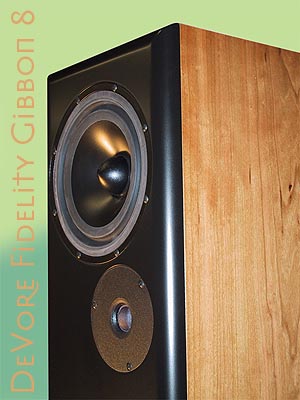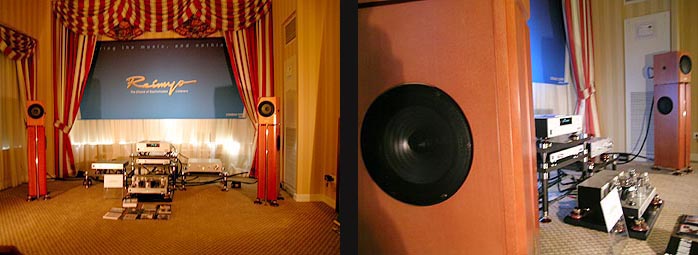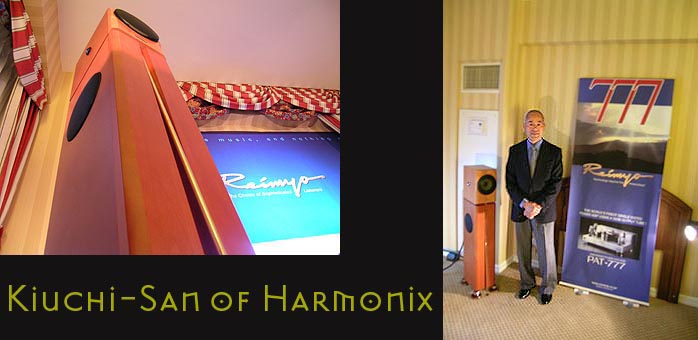 |
|
|
|
 |
|
|
The CD player spent equal time in both Connecticut and NY. The rest of the system spent much more time in NYC. On the other hand, I brought various parts of the system to my Connecticut reference system for comparison purposes and to double check the listening impressions and conclusions reached in the context of the full Reimyo system. Thus the line stage, amplifier and power line conditioner were in Connecticut for sustained individual listening sessions. I was anxious for the amplifier to spend some time with the Hørning Hybrid loudspeakers which are 98dB efficient and a particularly promising match. All in all, I listened to the preamplifier, CD player and amplifier through four different sets of speakers. I put a good deal of time into searching out synergistic matches that would put the system in its best light and which would enable me to identify the characteristic sound of the Reimyo components. At the end of the day, it was much easier for me to identify the character of the Reimyo sound than it was for me to disentangle the component parts from one another in order to assess the contribution each made to the overall sonic signature.
So What Is The Characteristic Sound?
In one string of adjectives: Rich, warm, big, rounded, relaxing and calming. Strangely perhaps given how inefficient it is, the Reimyo system spoke with one voice through the Bravo speakers. It may seem odd that the amplifier could successfully drive the reasonably
|
|
|
insensitive Bravos but it did quite nicely within a range that was perfectly appropriate for evaluation. Of course everything fell apart on large scale music at loud volumes but I rarely evaluate components at loud volumes. I am particularly concerned about the quality of resolution of audio components - and highly resolving components simply do not have to be played loudly (typically) in order to convey their capacity to resolve detail or display microdynamic contrasts. So it was through the Bravo -- a speaker cut from the same sonic cloth as the rest of the system after all -- that my first serious impressions of the Reimyo sound were formed.
Those who visited the Combak room at the recent Home Entertainment Show in New York City formed a similar impression. The Reimyo room was a sanctuary of sanity and calm. One would drop by to slow down and relax and be awash in beauty. The room was often overflowing with visitors especially at the end of the day.
|
|
 |
|
|
In fact, if I had to use one word to describe the Reimyo sound, it would be beautiful. I mean to contrast that not just with 'harsh', 'unpleasant', 'piercing', 'hi-fi' and 'sterile' but also with 'real' and 'accurate'. The Reimyo sound is lush, big and beautiful but not at the same time true to life which, in fact, is harsh, piercing and unpleasant at times. Philosophers and logicians sometimes express differences in taste and judgment through the phrase "one man's modus ponens is another man's modus tolens". I feel that way about the phrase neutrality.
|
|
 |
|
|
I have a pretty well-developed sense of what neutrality in audio sounds like - I hear it in some components but not in others. On the other hand, I have no confidence that others, including many good listeners, share a common understanding of neutrality. Neutrality may well be the most contestable concept in the entire audio lexicon. It is contestable in two ways. First, it is quite contestable whether neutrality is desirable in a component or system; and if it is valuable or desirable, it is contestable just how desirable or valuable it is in comparison to other sonic attributes. Secondly, it is equally contestable what neutrality means or refers to. It is not at all clear that all those who use the term mean the same thing by it. As a result, debates about the value of neutrality are often doubly unhelpful. After all, if individuals don't mean the same thing by the term, then they are not so much disagreeing with one another when they appear to be contesting its value or desirability as they are in fact talking past one another. Until we have a shared understanding of the concept, I prefer to use other terms to characterize sound - though these too are likely to be contestable.
By my lights, it is just best to say that the Reimyo sound is not true to life itself; it is true to an interpretation of life that is optimistic, romantic, aspirational and joyous. One has to be careful here. The Reimyo sound is neither sugary nor saccharine. It does not present music as if one were looking through the world through rose-colored glasses. Rather, it is as if Mr.Kiuchi looks at the world and is inclined to see what is glorious and beautiful in and about it. It is the beauty inherent in the order of the universe, however that order happens to be manifested in the world we experience. However unpleasant or unkind the world; however often it refuses to cooperate with our expectations; there remains an inner beauty and harmony that we can put ourselves in touch with. It is that harmony and ordered beauty, not a sugar-coated Disney-esque vision, which the Reimyo sound portrays.
|
|
 |
Music played back through Reimyo equipment can come across as dark, dangerous or foreboding when called for. But taken as a whole, the Reimyo system is not capable of presenting music with edge or roughness. The music may be foreboding and the 'risk' worrisome but when the risks materialize, their impact is invariably softened. The message is never one of chaos, disorder or unrelenting dread. It is there to express the view that through it all, there is a deeper harmony and beauty that we have to open ourselves up to and embrace. The Reimyo sound may not touch or move a skeptic and certainly will not ring true for a |
|
cynic. It is most difficult for the agnostic or uncertain individual. How it strikes that person will depend much on whether such agnosticism and uncertainty are bleeding into doubt or into hope. The sound of Reimyo is resolving but none of the components are 'high resolution' with the exception of the digital pieces. Nor is the sound especially extended at either of the frequency extremes. It reaches for the heart both of the music and the listener and connects more often than not. It is no surprise then that the tonal center of the Reimyo sound is the natural portrayal of the human voice and a warm and gorgeous string tone especially on violins.
The Reimyo sound is as much aspiration as description. When reality is too much and you need to escape by listening to music, to be engulfed by its beauty and majesty, then what you crave is what the Reimyo can deliver. What the Reimyo sound does not deliver is a hard and cold look at reality. It simply cannot help but see the beauty and good in even the worst. That's the way the Reimyo presents music. Cynics and skeptics must look elsewhere for gratification.
|
|
How About The Individual Components?
I found it difficult at first to sort out the contribution each of the components made to the overall sound. I had previous experience with the CD player, the line conditioner and the Studio Master cords. The line stage and amplifier were new to me as were the interconnects and speaker cables. The CD player shared least in the overall Reimyo sound. If there is one piece in the line that is completely extended, open and detailed, it is the CDP-777. It has a strong character of honesty and integrity with a deeply musical soul. It is a virtually artifact-free machine and the best I have yet heard. It is not perfect, though. Nothing is. |
|
|
|
 |
|
When compared to the VRS hard-drive system that I have heard twice now in two different systems, it is a bit less alive and immediate. It backs off just a bit in comparison both to the Reimyo DAC and the VRS. In that way, it shares the tendency of all the Reimyo components to adopt a reserved and non-demonstrative approach to music playback. Outside of that, it is sonically far less a 'Reimyo' component than the other ones are to each other
I have had some experience with the Harmonix Studio Master power cords above and they too are among my favorites. Over the years, I have grown to appreciate the impact power cords can make in a system. At the same time, I have been amazed by how system-dependant power cords can be - even more so than interconnects and speaker cables. I have heard of only one basically sound system in which the Stealth Indra interconnect did not seem to work at least some of its magic. I know very few systems that cannot benefit from at least one Omega Mikro interconnect or speaker cable. To be sure, one has to be careful not to overdo it with certain cables and interconnects. Too much of a good thing can quickly turn into a bad thing. But I could easily recommend a handful of interconnects and speaker cables that will work admirably in a wide range of systems.
I wish I could say the same thing about power cords. The Harmonix Studio Master is as close as I have come in my own experience to a universal power cord as one that will invariably improve one's system, though other folks whose judgment I trust have a similar view about the very expensive Elrod cords. The Studio Master did not work well with the VRS system which surprised but did not shock me given the system dependence of power cords in general. The Studio Master is a big and, in my experience, open-sounding power cord. It is especially good at revealing details in a musically convincing way. It is not shelved down on top and seems to sort things out well in the lower midrange, the one exception being the VRS where it clogged up the band between midbass and lower midrange.
Like the CD player, the Studio Master tends not to be showy or demonstrative. In this regard, it was clearly of a piece with the rest of the Reimyo sound. It also has a slightly warm tonal balance and this too was in keeping with the overall Reimyo gestalt. Studio Masters remain among my reference power cords. It is not always my first choice but almost always a sound and dependable one. It may well be the most sensible power cord you can buy. But I'd heard the Studio Master in too many systems and under too many conditions to feel that it was at the heart of the overall Reimyo sound. I turned my attention next to the 300B amplifier.
|
|
|
The PAT777 is a two-stage 300B stereo amplifier that seems to be based on the WE 91 circuit. I originally thought the amplifier employed NOS Western Electric 300B tubes and was surprised and disappointed to find that it does not. Instead it uses current vintage WEs which are very good and comparable to the better 300B tubes available though I personally favor the TJ Mesh plates. I do not think the current production 300B tubes hold a candle to the originals which are in fact available in other production 300B amplifiers, including some that sell for considerably less than the Reimyo amplifier. I listened extensively to the amplifier in several systems and often but not always with its companion line stage. |
|
 |
|
|
Most audiophiles and many (too many mainstream) reviewers associate the 300B tube with a certain 'classic' 300B sound. That really is the sound of the 300B amplifiers they are familiar with: The ones much discussed and, in my view, unjustifiably praised machines in the mainstream US print journals. The classic 300B sound is a mix of desirable and less desirable traits. On the positive side, the classic sound is relaxed, immediate, personal and very much at ease. The music is unforced. It simply breathes naturally. On the downside, this relaxed sound often translates into a woolly bottom end and limited top extension. This in turn invites the view that the 300B sound is all about the midrange. In many ways, the classic 300B sound is. At the same time, the classic sound is very big and full. When the sound goes wrong, it comes off as fat and rounded, lush and inadequately detailed. If the only 300B amps I had heard were the ones so much talked about in the US print media, I would never have found the 300B sound to my liking.
Fortunately, the best I have heard have virtually none of these faults and are extended at the frequency extremes. I would not deceive you and claim that a good 300B amp can control the bass of a dynamic loudspeaker the way a good push/pull amplifier can. Still, good 300B amps can plumb the depths, present the lower registers with weight, authority and more than a modicum of control. We are not talking Spectral here but fast, taut and lean bottom octaves don't sound much like real music either. The best 300B amps are extremely detailed in the higher frequencies and some 300B amps can even err on the side of being a bit lean, not fat. Paired with sympathetic speakers, they also can be extremely dynamic. |
|
|
 |
|
|
|
 |
|
 |
|
|
|
|
|
|
|
|
|
|
|
|